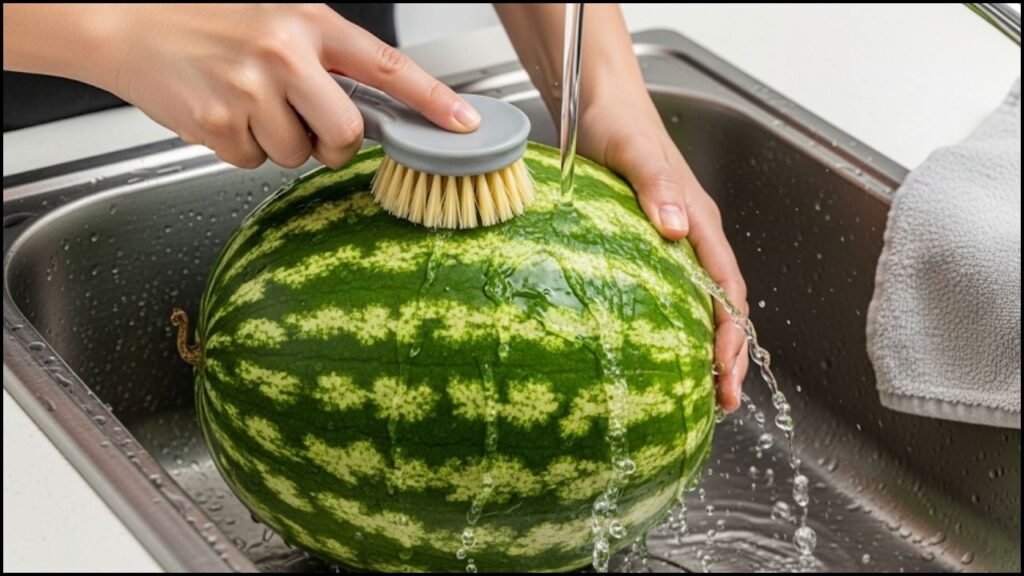
It’s a staple of summer picnics and backyard barbecues, but food safety experts warn that improper handling of watermelon can pose a significant health risk. Health officials stress the importance of a simple but critical step: you must wash watermelon thoroughly before cutting into it. Failing to do so can transfer harmful bacteria from the rind to the flesh, potentially leading to serious foodborne illness.
Key Takeaways: Watermelon Safety
For readers seeking a quick summary, here are the essential points regarding watermelon food safety, based on guidance from federal health agencies.
| Key Fact | Detail |
| Cross-Contamination Risk | A knife can carry pathogens like Salmonella and Listeria from the unwashed rind directly into the edible fruit. |
| Pathogens on Rind | Watermelons grow on the ground, exposing their surfaces to bacteria from soil, water, and handling during transport. |
| Washing Method | Scrub the rind firmly with a clean produce brush under cool, running water. Soaps and detergents are not recommended. |
The Hidden Dangers on the Rind
While the thick, green rind of a watermelon seems like a durable barrier, its surface can harbor dangerous microorganisms. Watermelons, like many other melons such as cantaloupe and honeydew, are grown in fields where they rest directly on the soil. This environment can expose them to bacteria from soil, contaminated irrigation water, and animal waste.
“The journey from the farm to your kitchen involves multiple points of handling, from harvesting and packing to shipping and stocking at the grocery store,” stated a food safety bulletin from the U.S. Food and Drug Administration (FDA). “Each step presents an opportunity for the fruit’s surface to become contaminated.”
Among the primary culprits are Salmonella and Listeria monocytogenes. While these bacteria are harmless if they remain on the rind that is discarded, they pose a threat the moment the fruit is sliced.

Why You Must Wash Watermelon Before Cutting
The most significant risk of fruit contamination comes from the act of slicing. When a knife passes through the unwashed rind, it effectively becomes a vehicle for transporting any surface pathogens directly into the sterile flesh of the fruit. “Consumers often assume that because they don’t eat the rind, they don’t need to wash it, and that is a critical mistake,” said Dr. Benjamin Chapman, a food safety specialist and professor at North Carolina State University, in an interview with the university’s news service. “The knife will pick up whatever is on the outside and drag it right through the part you are about to eat.”
This cross-contamination process is a well-documented cause of foodborne illness outbreaks. In 2011, a major multistate Listeria outbreak linked to cantaloupes resulted in over 140 infections and 33 deaths, according to the Centers for Disease Control and Prevention (CDC). While that incident was tied to a specific farm’s packing facility conditions, it underscored the vulnerability of melons to surface contamination.
The Correct Steps for Safer Slicing
To mitigate these risks, health authorities provide clear and simple food safety tips. Following this procedure can significantly reduce the likelihood of contamination.
Step-by-Step Washing Guide
- Wash Hands: Before handling any produce, wash your hands thoroughly with soap and warm water for at least 20 seconds.
- Rinse the Melon: Place the whole, uncut watermelon under cool, running tap water. Ensure the entire surface is rinsed.
- Scrub Firmly: Use a clean produce brush to scrub the entire surface of the rind. According to the FDA, scrubbing is essential to dislodge dirt and bacteria from the textured surface. Do not use soap, detergents, or commercial produce washes, as they are not approved for consumption and can be absorbed by the fruit.
- Dry the Melon: Pat the watermelon dry with a clean cloth or paper towel. Reducing moisture on the surface can help remove any lingering bacteria.
- Use Clean Equipment: Cut the melon on a clean cutting board with a clean knife. Sanitize your surfaces and utensils before and after they come into contact with raw produce.
Once sliced, watermelon should be refrigerated promptly at or below 40°F (4°C) and consumed within three to four days.
What About Pre-Cut or Organic Melons?
Consumers might wonder if these rules apply to all types of watermelons. Food safety experts confirm they do. An “organic” label refers to farming practices but does not guarantee the fruit is free from harmful bacteria. The potential for contamination from soil and handling remains, making the need to wash watermelon just as crucial.
Pre-cut watermelon purchased from a grocery store should have already been prepared in a commercial kitchen following strict food safety protocols. Consumers should only buy pre-cut fruit that is refrigerated or surrounded by ice. It is essential to keep it refrigerated and pay close attention to the “use-by” date.
Ultimately, the responsibility for safe food handling in the home rests with the consumer. “This simple act of washing is one of the most effective and easiest ways to protect yourself and your family from foodborne pathogens,” a CDC report on food safety concludes.
The Definitive Guide on How to Wash Blackberries for Optimal Safety and Flavor
